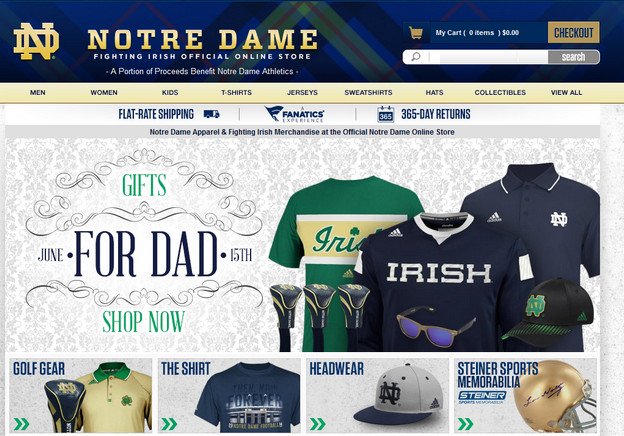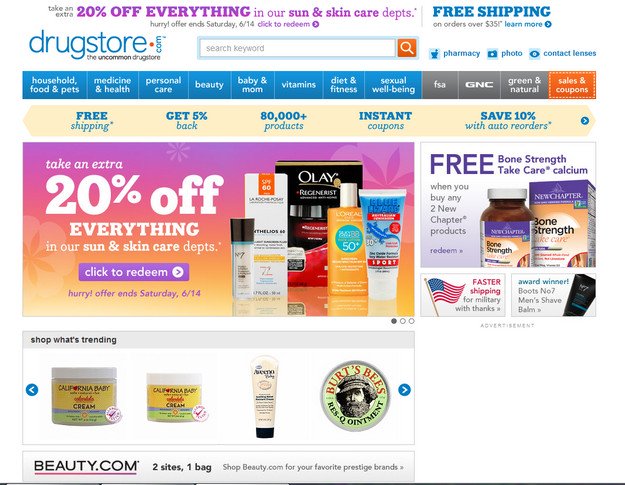Hewlett-Packard. Ben & Jerry’s. Even Microsoft and Apple were born out of a partnership. These days, when competition is fierce and you can’t afford to compete on price alone, a partnership may be a smart business move. Online partnerships happen every day, when Company A has something valuable to offer Company B wherein both businesses benefit and grow as a result.
But how can you leverage these kinds of partnerships to grow your own business goals? Let’s take a closer look at four little-known examples and learn how they used the power of partnerships to boost their bottom line (and how you can too!).
1. Brand Piggybacking: Notre Dame and Fanatics.com
Fanatics.com is well-known as the web’s largest online retailer of officially licensed sports merchandise, so it’s only natural that the Fighting Irish would choose them to power their online store. Many colleges and universities elect to run their own e-commerce shops, but none of them have the name recognition and “fanatical” service that has become ingrained with the Fanatics.com brand.
According to Daniel Skendzel, Digital Media Program Director for the University of Notre Dame, the university “ultimately chose Fanatics because of the company’s focus on the e-commerce shopping experience. They are annually among the highest rated firms in customer service. They have a proven track record for delivering an outstanding product assortment. They have invested in technology and infrastructure to ensure fast and accurate product fulfillment. We are pleased to be working with an industry leader like Fanatics”.
What You Can Learn From Them
When you can take advantage of the existing goodwill and industry-leading name recognition of an existing brand far easier than trying to establish your own store independently, it makes sense to piggyback on that brand. This is why many publishers and online stores take advantage of Amazon and Google Shopping as an additional outlet for their merchandise. Big name online brands have far greater reach and exposure, so why compete when you can cooperate?
2. Go Beyond Being a Solution Provider: Apptive and Mobile Commerce
There are plenty of mobile commerce providers on the web, all promoting a near-instant, beautifully-rendered mobile version of your site. So what makes Apptive, an m-commerce provider, so different? Rather than shout about their services in a digital echo chamber, Apptive partnered with leading e-commerce providers Volusion, BigCommerce and Shopify to enhance their existing offerings by integrating its mobile commerce tools with the service providers’ existing click-and-build e-commerce templates.
As their customers say, “Apptive is a really exciting addition to my marketing toolbox,” says Tahnee Elliot, owner of TC Elli’s and a Bigcommerce customer. “My boutique clothing store is in a college town where I’d estimate over 90% of my customers are smartphone users. Giving them a super easy way to interact with my store from their smartphone and gaining a new direct communication channel with push notifications has been awesome.”
What You Can Learn From Them
Even when you’re in an ultra-competitive niche, customers will tune you out if you’re shouting from an island about how you offer the best services for the lowest prices. The fact is, they know they have plenty of choices. Simply being online and offering ease of use technology is no longer enough to set you apart. You have to embrace the tools your customers are using, and look for ways to make it easier to boost both your service, and the services your buyers frequent.
3. Look for Unique Ways to Accentuate Other People’s Products and Services: Valpak and Samsung
On the subject of integrating with the tools your customers are already using – we have Valpak. In the U.S., Valpak is synonymous with coupons-by-mail, and their mailers are both loved and loathed by residents around the country for their coupons and the assorted junk (including promotions and sweepstakes) that come with them.
In a unique partnership with Samsung, Valpak developed an app that would let Galaxy and Galaxy Note users manage their coupons, savings, tickets and loyalty points direct from their devices. In an added twist, Galaxy users could also receive proximity alerts on their smartphones of alerts and sales in their area. They could pick and choose which coupons were most relevant to them, or turn off the feature altogether, giving them the freedom and flexibility to stay up to date on new notifications from the shops they loved and frequented.
What You Can Learn From Them
By looking for ways to accentuate other people’s products and services, Valpak positioned itself as front-of-mind in a consumer-driven, deal-hungry marketplace. Samsung enjoyed the benefit of an exclusive product that only users of their higher end devices could participate in, thus giving them a channel into a lucrative, hard-to-reach market. What are some ways that you could add to other people’s products and services in a way that you both benefit?
4. Around the Corner, Around the World: Drugstore.com and E4X
You may recognize the name Drugstore.com, but what is E4X? As it turns out, they offer geo-location services that can identify where a customer is browsing from, and adjust a site to fit the local currency and culture. Today, Drugstore.com operates a presence in 52 countries, dynamically recommending products to international audiences around the world.
Chief marketing officer David Lonczak notes that “International sales represent a pillar of growth for Drugstore.com… Online retailers of all sizes can avoid certain problems of selling overseas by first getting to know their potential customer base, exposing them to the right products and finding good technology partners.”
What You Can Learn From Them
There’s no shortage of sites experiencing international blunders after launching in foreign countries unprepared. As such, Drugstore.com took the time to get to know their buyers in each country, while investing in the technology and infrastructure needed to cater to their unique needs. Finding a company that excels in an area of specialization that makes it easier for customers to do business with you is a no-brainer when it comes to forming a strategic partnership!
Creating Your Own Partnership Plan
With each of these companies, and many more, each strategic partnership vision started with a plan. Outline what it is you hope to receive, and perhaps more importantly, what your partner should receive as a result of working together. Leave the sales pitch at the door and concentrate on building a real, solid relationship with key decision-makers.
Even if they don’t seem “sold” on the idea at first, getting them to open up and explain their goals will allow you to tailor your plan so that it more precisely meets their objectives, while concurrently meeting your own. Good luck!
About the Author: Sherice Jacob helps businesses improve website design and increase conversions with user-focused design, compelling copywriting and smart analytics. Learn more at iElectrify and get your free conversion checklist and web copy tune-up.



Comments (3)